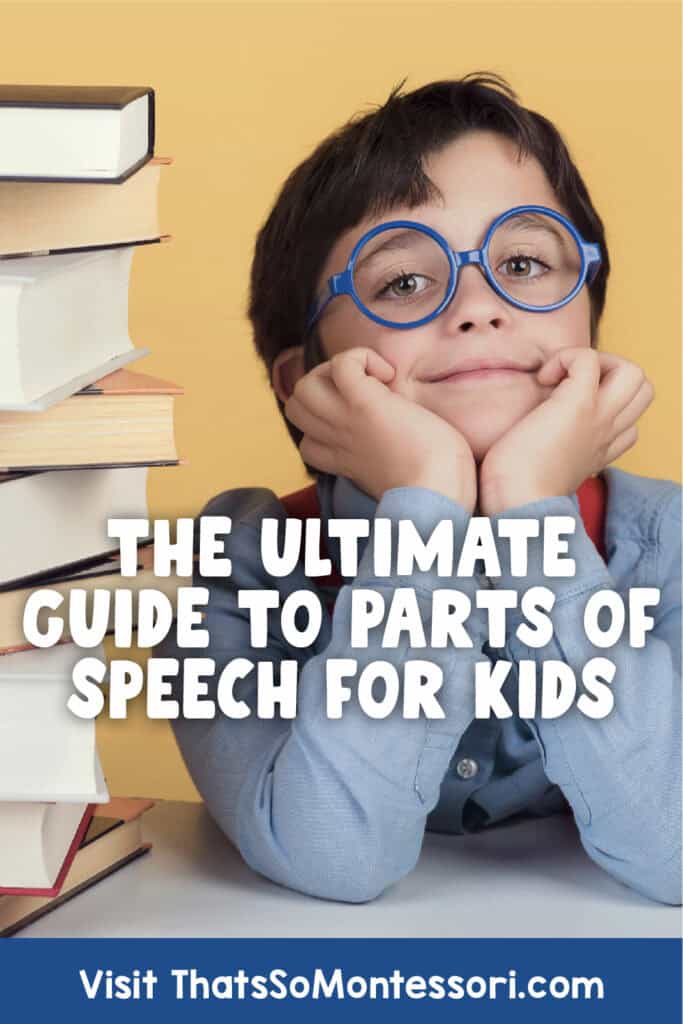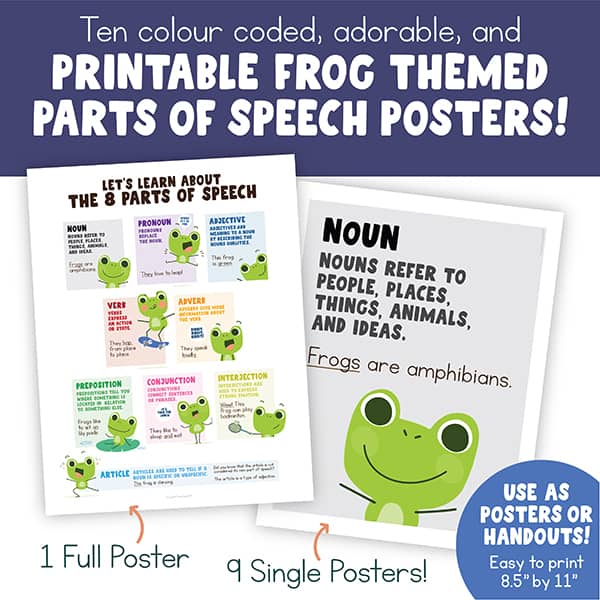Parts of Speech for Kids: The Ultimate Guide
Explore the world of parts of speech for kids through this comprehensive guide. Drawing on my expertise in Montessori education, this resource simplifies nouns, verbs, adjectives, adverbs, pronouns, prepositions, conjunctions, and interjections for young learners.
As you navigate this guide, you’ll notice the Montessori influence, making language learning engaging for children children in the second plane of development.
You’ll also find many fun example sentences that make understanding the parts of speech a blast! And be sure to watch the engaging parts of speech videos with catchy songs that we included. Your students will love them!
Keep reading to discover how to equip your elementary students with essential knowledge about the 8 parts of speech.
💡Parts of Speech Posters
Check out our adorable and educational parts of speech posters for kids. Designed for your elementary classroom walls and Language area folders, they’re suitable for any learning space!
Get yours here!
The Parts of Speech
There are over 1,000,000 words in the English language.
While many of those words would now be considered archaic, one thing that they all have in common is that they all be classified into a part of speech depending on how they are used.
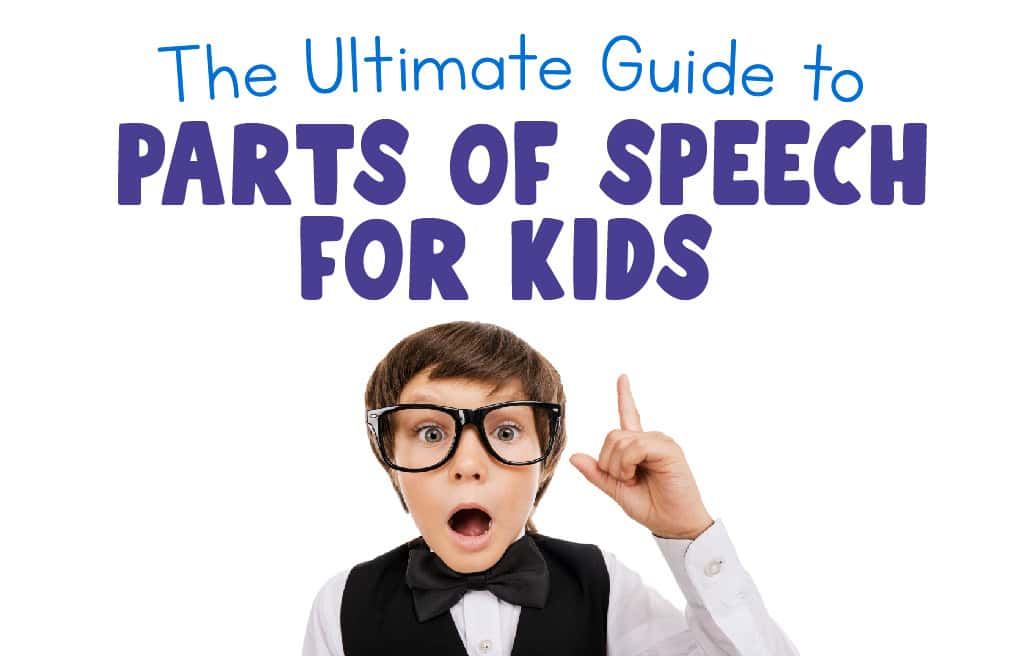
The parts of speech in English – also referred to as word classes – are considered the building blocks of grammar. Each part of speech explains how the word functions in meaning as well as grammatically within a sentence.
Let’s take this a step further and take a look at what comes up when you search for ‘parts of speech’ in a dictionary.
Defining Parts of Speech
➡️ Merriam-Webster Dictionary: A traditional class of words (such as adjectives, adverbs, nouns, and verbs) distinguished according to the kind of idea denoted and the function performed in a sentence.
➡️ Britannica Dictionary: A class of words (such as adjectives, adverbs, nouns, verbs, etc.) that are identified according to the kinds of ideas they express and the way they work in a sentence.
➡️ Oxford Learner’s Dictionary: One of the classes into which words are divided according to their grammar, such as noun, verb, adjective, etc.
💡 Teacher Tip: Have your students define parts of speech on their own!
When students express concepts in their own words, it strengthens their overall understanding of a topic. Awesome!
Each word in every sentence works together while also performing different tasks. Understanding how words function is key.
This is why in the Montessori elementary language curriculum, the 8 parts of speech play an integral role in lower elementary learning.
The Eight Parts of Speech for Kids to Learn About
Fun Fact: While some say it is, the article is not its own part of speech.
It’s is a special class of adjective that gives more information about a noun.
The Ultimate Parts of Speech Guide for Kids
It’s time to take a close look at the 8 parts of speech! This resource is perfect for teaching or sharing with your elementary students.
Let’s start with a great song to set the mood for our parts of speech journey!
I like to begin my lessons on the parts of speech for elementary students with a video like this. Just be prepared to have this tune in your head for a bit!
⭐ TEACHER TIP: Save this blog!
This guide with parts of speech definitions and examples is ideal for elementary classrooms. Keep it handy for your grammar lessons.
Nouns
Nouns are words that are used to refer to the names of people, places, a thing, or a collection of things, animals, and ideas. There are many different types of nouns and each one serves a specific purpose.
Common and Proper Nouns
Nouns can be categorized as common nouns or proper nouns.
Common nouns refer to general terms or items, such as cat, bicycle, and house.
Common Noun Example Sentences (common nouns are in bold):
That cat is so fluffy.
We should go to the library.
I made sushi last night.
Did you meet my brother?

Proper nouns name specific nouns and are always capitalized.
Proper Noun Example Sentences (proper nouns are in bold):
Tomorrow I’m flying to France.
I have a craving for Odd Burger.
Throughout the performance, Lilly acted brilliantly.
The most widely spoken language is English.
💡Looking for a fun way to emphasize the properness of proper nouns?
Our activity book Draw, Doodle, Scribble, Think, Create features a prompt where kids can write their name in different styles. This helps reinforce the capitalization of names while fostering creativity.
Read why your kids need this activity book with fun drawing prompts!
Singular and Plural Nouns
Another way to categorize nouns is to identify if they are singular or plural.
A singular noun is only one person, place, or thing while a plural noun refers to more than one person, place, or thing.
Singular Noun Example Sentences (singular nouns are in bold):
The class has a pet rabbit.
She planted one tree outside.
He is baking a cake today.
I use a pencil to draw.
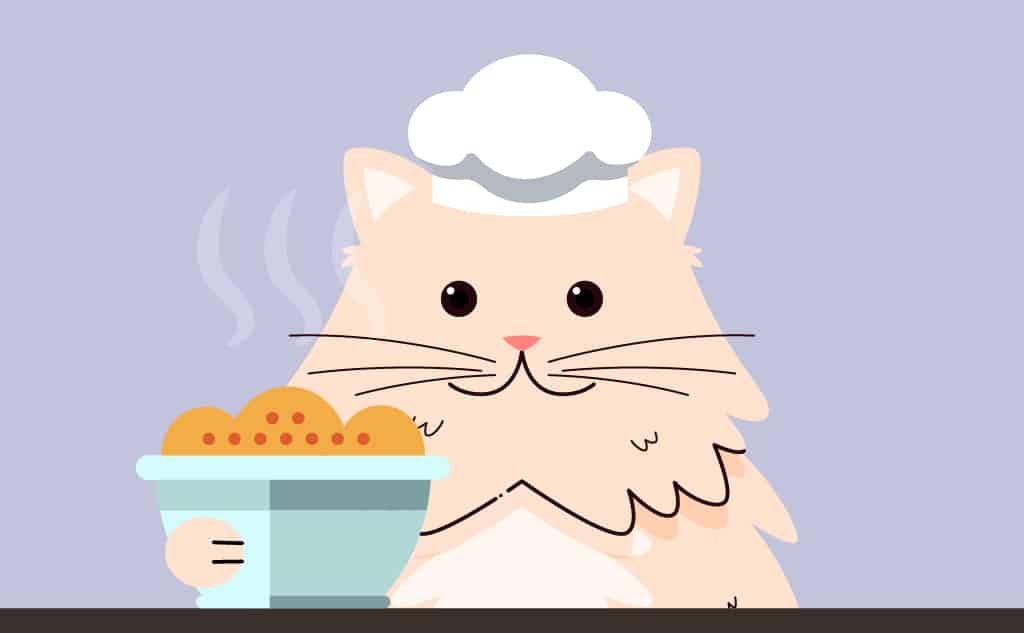
Plural Noun Example Sentences (plural nouns are in bold):
Put the bag of footballs inside.
You stole my ideas.
We should order the storybooks online.
The school hired many new teachers.
Concrete and Abstract Nouns
Nouns can also be identified as concrete or abstract.
Concrete nouns exist physically. You can experience them with your senses. Think of things that you can see, taste, touch, smell, and hear.
Concrete Noun Example Sentences (concrete nouns are in bold):
Your dog is cute.
Pass the book, please.
Please wear a jacket outside.
Use an easel to draw.
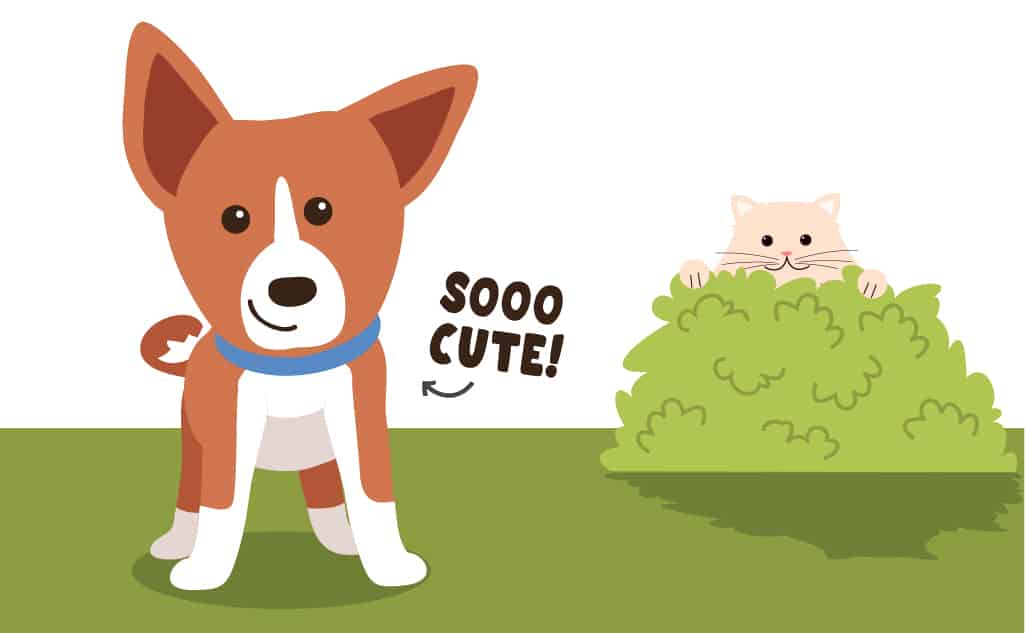
Abstract nouns refer to an idea, quality, or feeling rather than a concrete object. It’s something you cannot grasp physically.
Abstract Noun Example Sentences (abstract nouns are in bold):
Students practice independence in the classroom.
The cat is very curious.
In my opinion, this restaurant is overpriced.
They laughed at the inventor’s idea.
Countable and Uncountable Nouns
Nouns can also be categorized as countable or uncountable.
Countable nouns are nouns that can be counted, regardless of if they are singular or plural.
Countable Noun Example Sentences (countable nouns are in bold):
There are six bikes in the garage.
There are twelve candles on the cake.
M neighbor has two big brown dogs.
He can play several musical instruments.
Uncountable nouns include nouns that can be measured but not counted. Things like intelligence and oat milk!
They also include all abstract nouns (an idea, quality, or feeling) and usually do not take plural forms.
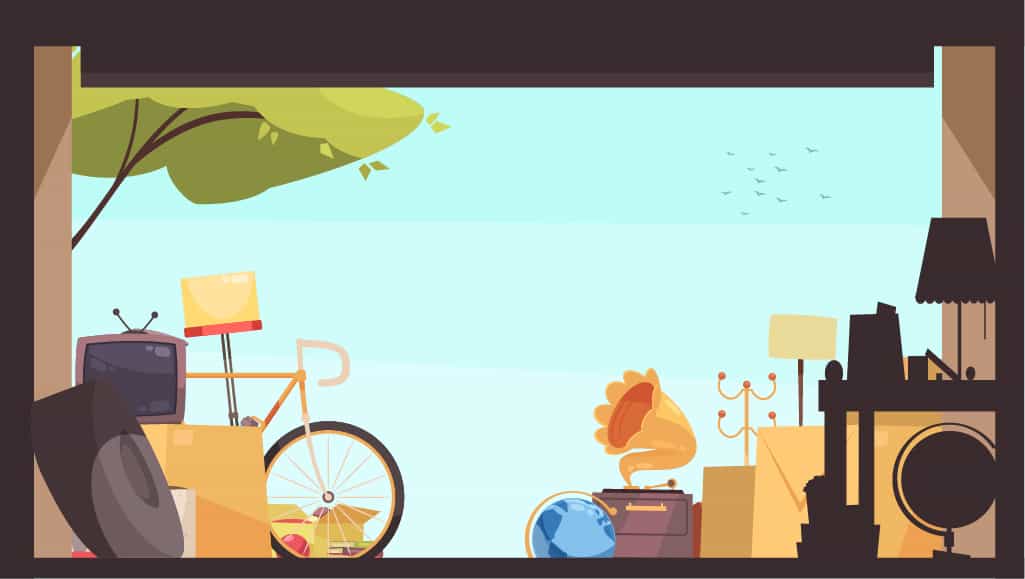
Uncountable Noun Example Sentences (uncountable nouns are in bold):
The garage is full of clutter.
Most kids like oatmeal, but Mickie loathes it.
He’s looking for information on Greece.
Remember to take out the garbage.
Collective Nouns
Did you know that nouns can also be collective?
A collective noun refers to a group of something particular and is treated as a singular noun even though it describes more than one noun. Interesting!
Collective Noun Example Sentences (collective nouns are in bold):
The boat’s crew worked all night to stop the leak.
The sheep huddled in a tight flock to ward off the cold weather.
A swarm of bees surrounded the hive.
The farmer planted a hill of beans.
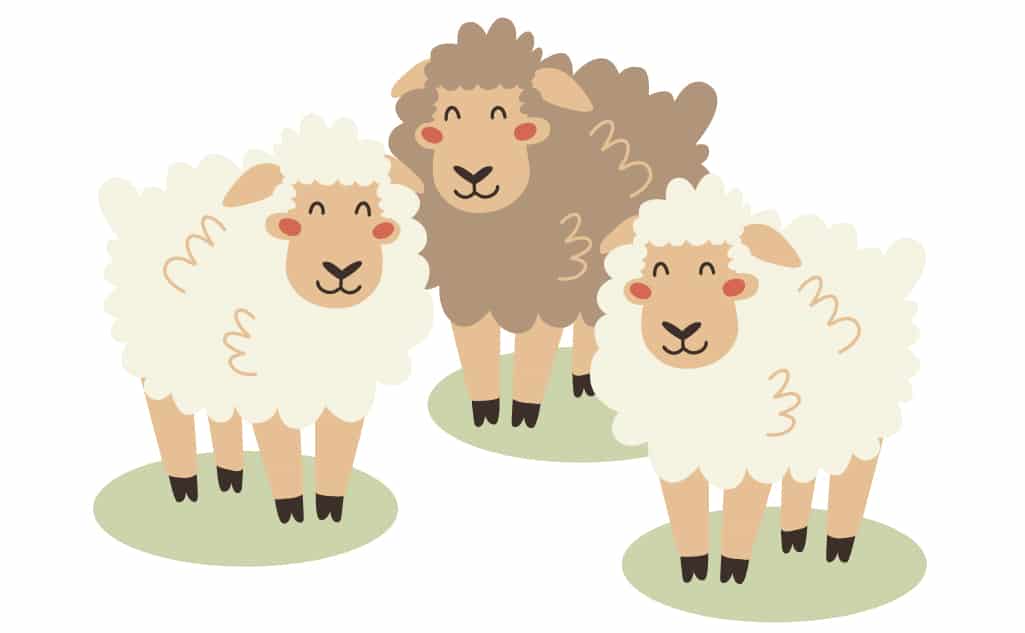
Compound Nouns
There’s even more about nouns! They can also be compounds.
A compound noun, typically known as a compound word, combines two or more nouns into one. These nouns can show themselves as a single word, as multiple words used separately, or as words that are connected by a hyphen.
Compound Noun Example Sentences (compound nouns are in bold):
We need to buy more toothpaste.
You should get some ice cream while you are out.
Remember to pick up the dry-cleaning.
I really need a haircut.
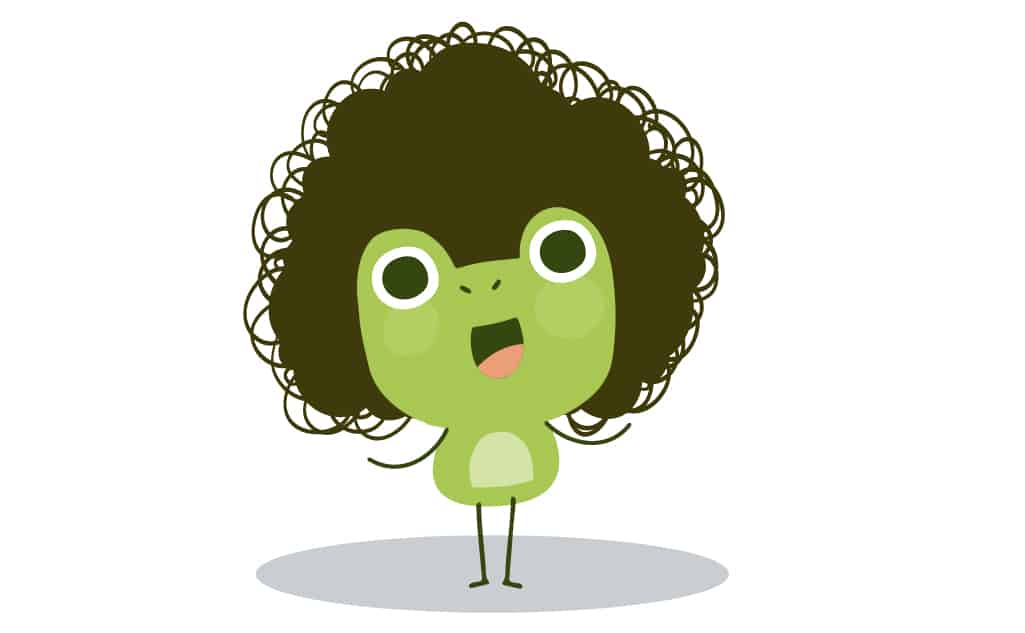
As you can see, there are a lot of nouns. Actually, nouns make up the majority of the English language.
Nouns, crucial in language, identify people, places, things, animals, or ideas, making them vital parts of speech for kids to learn.
Ready for another song about the parts of speech for kids to obsess over?
Consider integrating engaging parts of speech videos with catchy songs into your elementary lessons! They’re always a hit in my classroom.
While this song doesn’t cover all the nouns listed in this guide, it provides a fun and rhythmic learning experience.
When a noun needs a break, the pronoun steps in. Understanding parts of speech for kids in elementary is essential.
Pronouns
Pronouns are words that take the place of a specific noun.
The word pronoun actually originates from a Latin word meaning ‘in place of the noun’.
When a writer wants to avoid repetitive use of a particular noun they will replace the noun with an appropriate pronoun.
I always advise my students: “noun, pronoun, pronoun, noun” when writing. Using two pronouns after a noun enhances flow and readability.
❌ Mr. Kwen is my teacher this year. Mr. Kwen plays word games twice daily to build his vocabulary. Mr. Kwen likes to talk about his cat. Mr. Kwen is a nice person.
✅ Mr. Kwen is my teacher this year. He plays word games twice daily to build his vocabulary. He likes to talk about this cat. Mr. Kwen is a nice person.
A quick fix to a sentence that repeats a noun over and over is to use pronouns. Try it out with your students!
Just like nouns, pronouns can be classified and organized depending on their function. Let’s take a look at the different types of pronouns.
Subject Pronouns
Subject pronouns take the place of and operate as the subject of a verb in a sentence. They are the noun performing the main action in a sentence.
The subject pronouns are: “I, you, he, she, it, we, they, who”.
Subject Pronoun Example Sentences:
She is going to the beach later in the afternoon.
You have to come to my housewarming.
We traveled to a new country during the summer break.
It smells very delicious in the kitchen.

Object Pronouns
Object pronouns take the place of and operate as the object of a verb in a sentence. This means they replace the noun that is receiving the action in a sentence.
The object pronouns are: “me, you, him, her, it, us, them, whom”.
Object Pronoun Example Sentences:
Barb told them a great story.
Grandma baked cookies for me.
The dog followed her.
Wait for us!
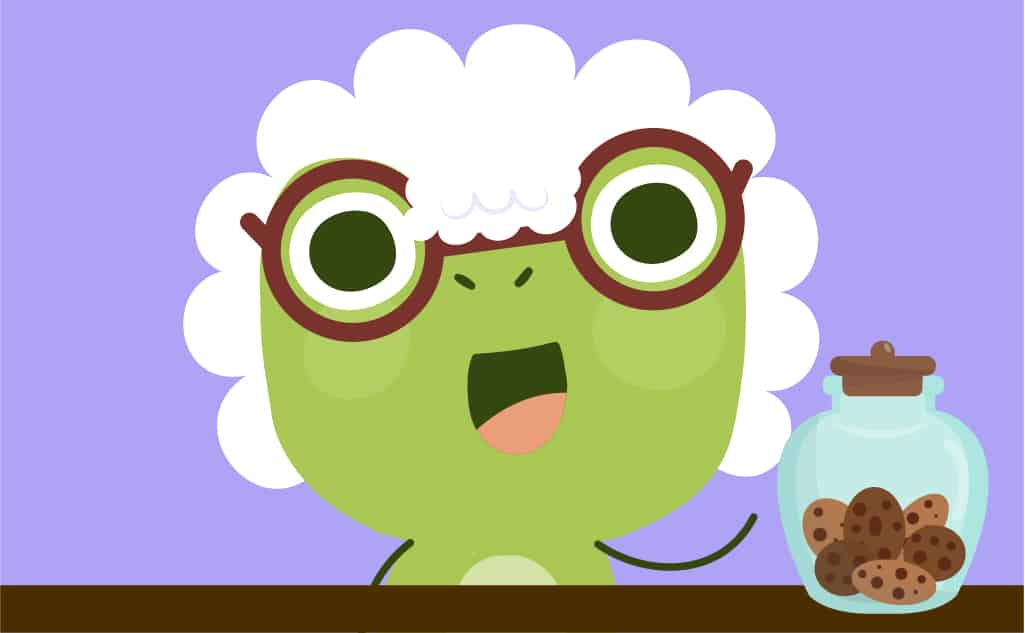
Possessive Pronouns
We use possessive pronouns to show ownership. These pronouns make it clear and let people know what belongs to who!
The possessive pronouns are: “mine, yours, his, hers, its, ours, theirs, whose”.
Possessive Pronoun Example Sentences:
I believe that is his hat.
Those sneakers are mine, not yours.
Your cat is cute, but not as adorable as ours.
The child noticed that the neighbor’s dog was bigger than hers.

Reflexive Pronouns
Reflexive pronouns are used when both the subject as well as the object of a sentence are the same. This type of pronoun refers back to the subject of the sentence.
The reflexive pronouns are: “myself, yourself, yourselves, himself, herself, itself, ourselves, themselves”.
Reflexive Pronoun Example Sentences:
You need to do it yourself.
Wesley made herself coffee.
The dog isn’t going to walk itself.
Grandpa and I painted the trailer together ourselves.
Intensive Pronouns
Intensive pronouns are used to add emphasis.
While they are similar to reflexive pronouns, the two can be differentiated in quite an easy way. If the pronoun is NOT essential to the meaning of the sentences then it is intensive.
That’s right! Read over the sentence and ask yourself, is that pronoun’s presence required? Can you make sense of the sentences without the pronoun? If so, you’ve got yourself an intensive pronoun.
Intensive Pronoun Example Sentences:
I myself like to travel.
They completed the task themselves.
The wound healed itself quickly.
Santina herself paid for the book.
Just like the reflexive pronouns, the intensive pronouns are also: “myself, yourself, yourselves, himself, herself, itself, ourselves, themselves”.
Demonstrative Pronouns
Demonstrative pronouns are used to point to specific nouns.
These nouns may be near and they may be far, there might only be one or there could be many. This is why we use four different demonstrative pronouns to specify things.
The demonstrative pronouns are: “this, that, these, those”.
Demonstrative Pronoun Example Sentences:
This is my dog.
That house is old.
These are my new shoes.
Those children like to play basketball.
Interrogative Pronouns
Interrogative pronouns are used to interrogate, or ask questions.
There are five of these pronouns and each one is used for asking a specific type of question. Note that sentences with interrogative pronouns end with a question mark.
The interrogative pronouns are: “what, which, who, whom, whose”.
Interrogative Pronoun Example Sentences:
What do you want for lunch?
Which colour do you prefer?
Whose books are these?
Who is knocking at the door?
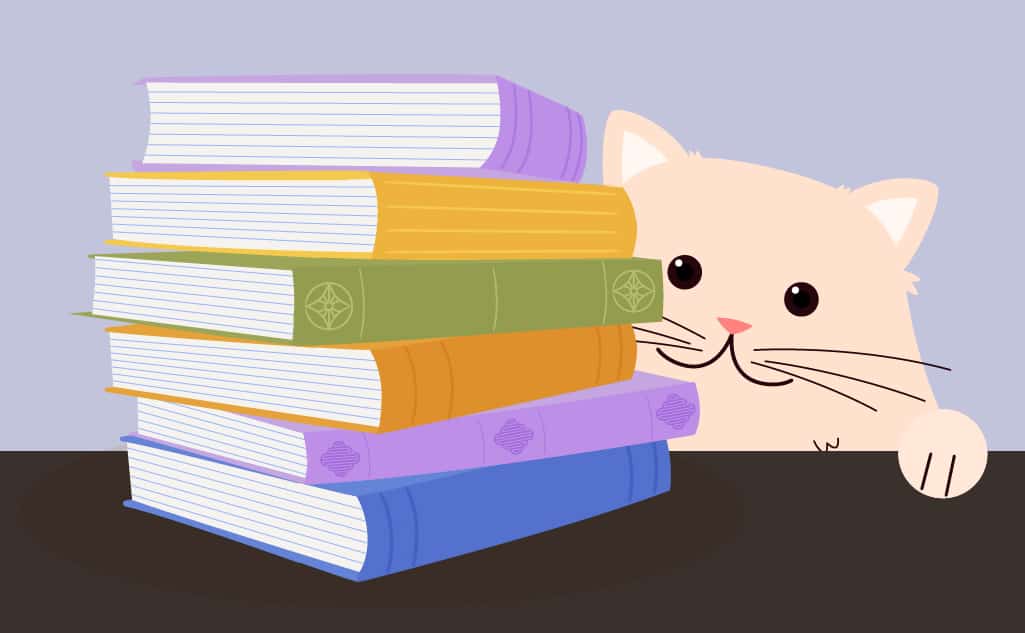
Pronouns are helpful because they can be used instead of a certain noun. With so many to choose from, pronouns make great choices when you want to avoid repetition in sentences.
Adding detail to nouns and pronouns makes sentences stand out. This can be done with adjectives.
Adjectives
Adjectives are words that modify a noun or a pronoun.
They help describe people, places, things, or a collection of things, animals, and ideas. Adjectives make sentences more meaningful by adding descriptive words.
Similar to other parts of speech, not all adjectives are created equally. Adjectives can be classified in several different ways all depending on the role they play in a sentence. Here we outline some of the most common adjectives.
Descriptive Adjectives
Descriptive adjectives are most likely what comes to mind when you hear the word adjective.
Also known as adjectives of quality, descriptive adjectives tell us something about the quality of the noun or pronoun.
Descriptive Adjective Example Sentences:
My family ordered a large vegan pizza for dinner.
She made delicious cookies.
There are beautiful flowers in the garden.
He is a smart teacher.
Quantitative Adjectives
Quantitative adjectives indicate a particular number or amount of a noun or pronoun.
These adjectives can provide a specific amount or an estimation.
Quantitative Adjective Example Sentences:
I ate two slices of cake.
The student read half of the book.
He has enough money to buy candy.
They gave their teacher some flowers.
Comparative Adjectives
Comparative adjectives are used to compare two nouns or pronouns.
Comparative Adjective Example Sentences:
Elephants are larger than lions.
The sequel was funnier than the first movie.
I like the vegan option better.
She is more active than her brother.
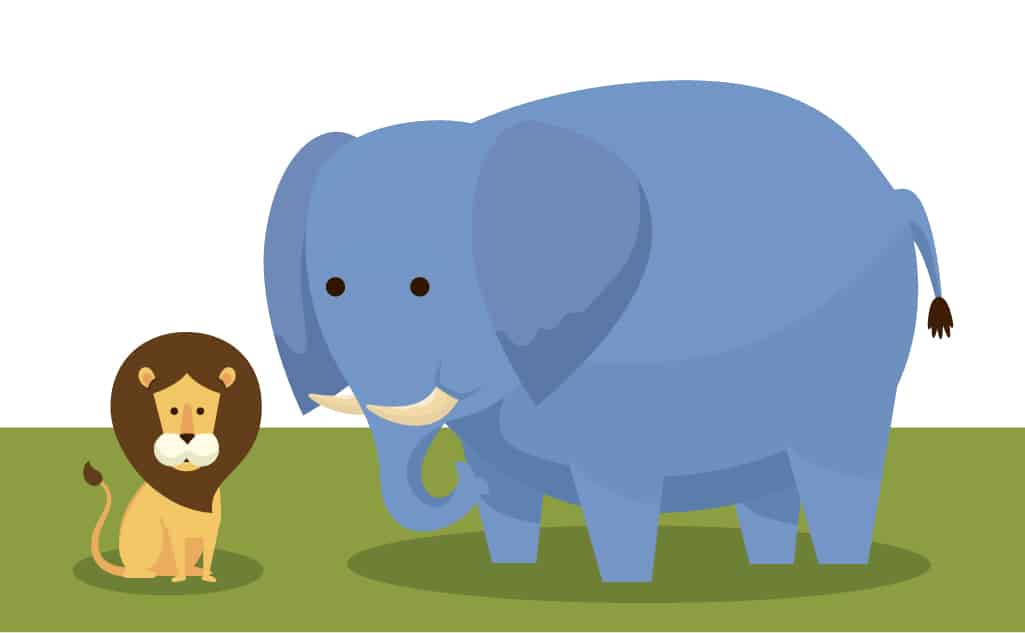
Superlative Adjectives
Superlative adjectives are used to compare more than two nouns or pronouns.
They indicate the upper or lowermost when comparing things.
Superlative Adjective Example Sentences:
The cheetah is the fastest land animal.
This mango is the most delicious fruit I’ve ever had.
The sun is the biggest star that we can see.
My brother is the oldest boy at the party.
Possessive Adjectives
Possessive adjectives show possession.
They usually come before the noun or pronoun to show who or what owns it.
They are sometimes confused with possessive pronouns, and I fully get why!
Some of the most commonly used possessive adjectives use the same word as some of the possessive pronouns. Knowing the context within a sentence here is key!
The possessive adjectives are: “my, your, his, her, its, our, their, whose”.
Possessive Adjective Example Sentences:
My shirt is blue.
Her dog is small.
We started our work at noon.
Did the cat eat all its food?
Demonstrative Adjectives
Demonstrative adjectives identify a noun or a pronoun by expressing its position as near or far.
Also known as determiners, demonstrative adjectives allow us to know which specific noun is being mentioned.
The demonstrative adjectives are: “this, that, these, those”.
Demonstrative Adjective Example Sentences:
Put those cans in the pantry.
This chair is broken.
These flowers smell nice.
That workout was exhausting.
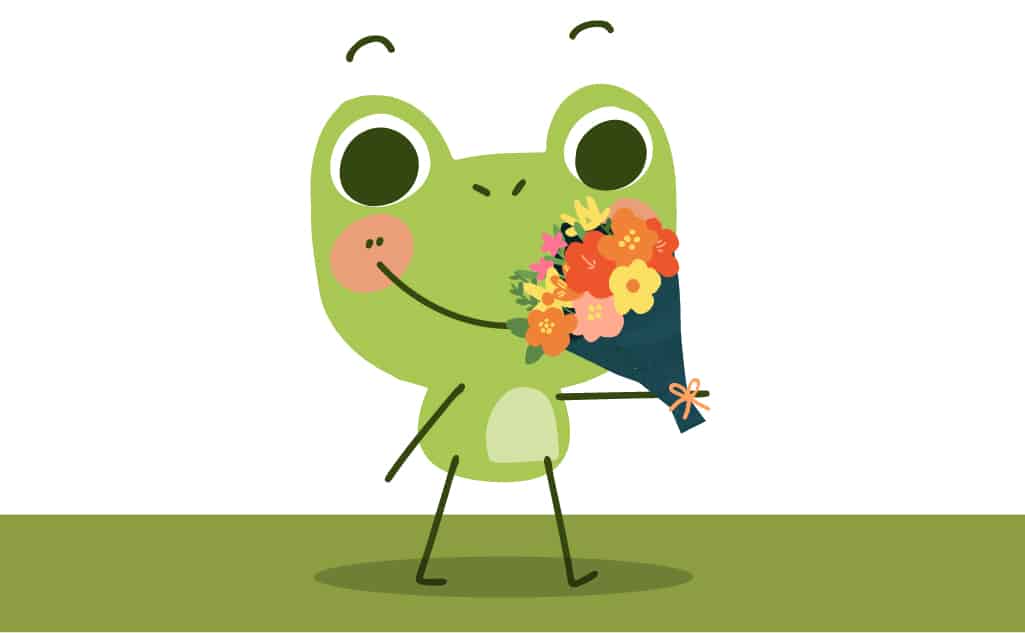
Interrogative Adjectives
An interrogative adjective is a word that describes a noun by asking a question.
There are used along with nouns to ask questions.
The interrogative adjectives are: “what, whose, which”.
Interrogative Adjective Example Sentences:
Which pen do you like more?
What recipe did you choose to make?
Whose photo is this?
What flower do you like best?
Proper Adjectives
A proper adjective is formed by a proper noun, and therefore needs to start with a capital letter.
These adjectives look quite similar to their original proper nouns but differ in ending.
Proper Adjective Example Sentences:
I enjoy many types of food, but Japanese food is my favourite.
The Asian continent is the largest in the world.
We watched a Shakespearean play in the park.
African drums are really fun to play.
Articles
The article is in fact a type of adjective. And since it is an adjective, it too functions to modify the noun or pronoun.
There are two articles in the English language: ‘the’ and ‘a/an’.
‘The’, known as the definite article, is used to refer to a specific noun or pronoun.
‘A/an’ is used to identify non-particular nouns or pronouns, and is also called the indefinite article.
Article Example Sentences:
I want to watch a movie.
You need an umbrella to walk outside.
The dog is hungry
I need a kilogram of chocolate.
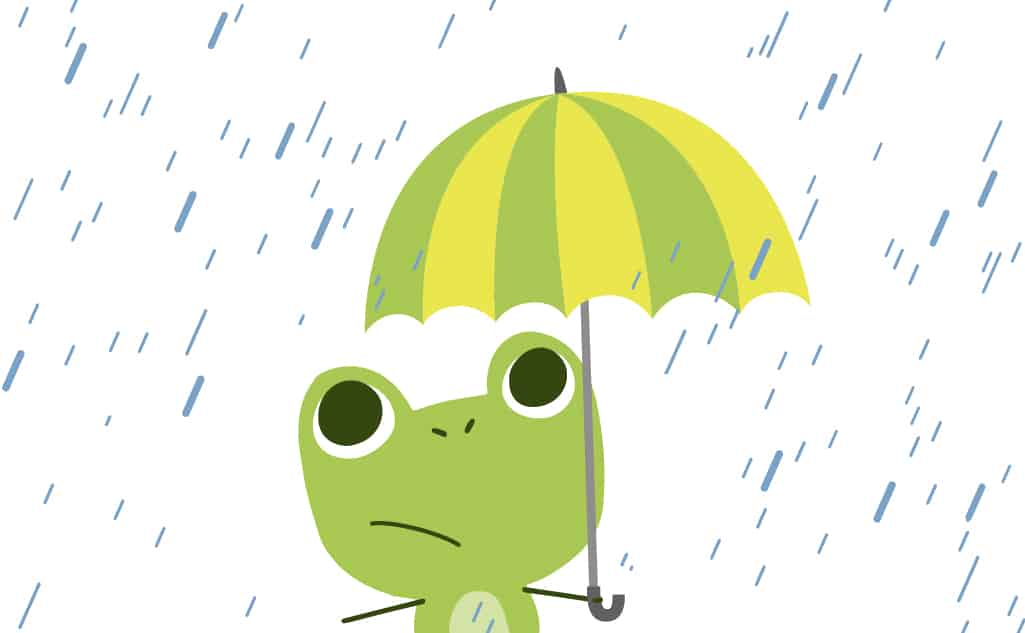
As you can see, adjectives are a comprehensive part of speech for kids to learn. Without them, students are unable to clearly state if a book they read is great or if all the hype is overrated. Descriptive words sure are powerful!
Now when verbs are added to these words it truly puts a sentence into motion.
Verbs
Verbs are used to express an action or a state.
They are the words in a sentence that express what the subject is doing. That’s why they are sometimes referred to as ‘doing words’.
There are different types and forms of verbs, and not all verbs are actually actions. Read on to learn all about verbs!
Action Verbs
Action verbs, sometimes called dynamic verbs, describe an action. Jump, eat, smile, and dance are all action verbs. They are all things you can do. Doing words.
Action Verb Example Sentences:
She walked the dog.
The children hiked in the forest.
Please close the door.
The bus arrived on time.
You need to show your young learners this video!
This song highlights the verb, the part of speech that is all about action, and the video is really fun to watch!
Stative Verbs
Stative verbs describe a state of being that you cannot actually see or touch, but more something you feel.
Typically followed by a direct object, these verbs do not perform any visible action.
Stative Verb Example Sentences:
I want a new pair of shoes.
In the morning, I prefer tea.
I love you.
You deserve a gift.
Regular Verbs
Regular verbs make up the majority of verbs we use in English.
These are verbs that only need to add ‘-d’ or ‘-ed’ to make the past tense form of the verb.
Regular Verb Example Sentences:
I played a new video game.
You studied math for hours.
We learned a song at school.
The baby cried all night long.
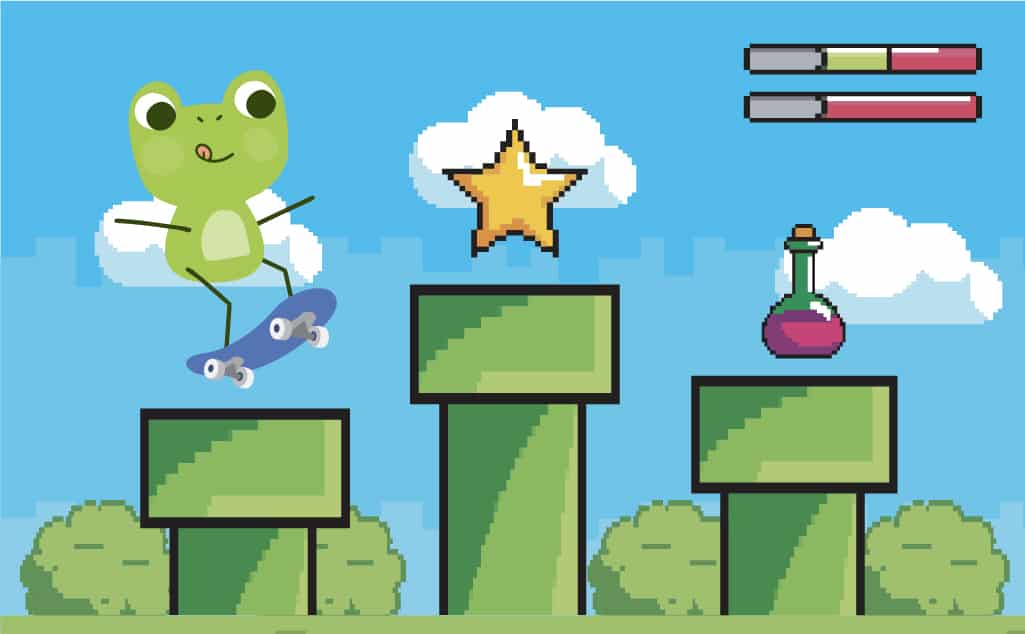
Irregular Verbs
Irregular verbs are not regular. They change their form when in the past tense.
These verbs do not follow the grammar rule of adding ‘-d’ or ‘-ed’.
Irregular Verb Example Sentences:
You swam well yesterday.
I read the whole book in one day.
He drank a glass of water.
The baby slept peacefully.
💬 Need Montessori-aligned quotes for your classroom?
Check out these articles:
35 Montessori Quotes for Inspiring Peace
77 Montessori Quotes to Fuel Your Child’s Success Story Now
Transitive Verbs
Transitive verbs express action and are followed by a direct object.
In fact, you can say that they “transfer” their action to the direct object in the sentence.
On its own, a transitive verb sort of leaves you hanging and doesn’t really express a complete thought. It needs a direct object to implement an action on.
Transitive Verb Example Sentences:
Remember to return your library books.
My sister plays the piano.
They closed the shop early.
The student broke his pencil.
Intransitive Verbs
Intransitive verbs, like transitive verbs, express an action, but unlike transitive verbs, they are not followed by an object.
However, they can be followed by a group of words, also known as a phrase.
These verbs do not require a direct object to form a complete thought. They can do it all on their own. Independence!
Intransitive Verb Example Sentences:
The boat floats in the bathtub.
They skate nicely together.
The wind blew hard.
They jumped so high.
Linking Verbs
Linking verbs are different from typical action verbs because they do not indicate an action in a sentence.
While they are not moving the sentence with action, they are connecting the subject to more information about that subject. Weird, right?
The common linking verbs are the forms of the verb ‘to be’, verbs relating to the five senses, as well as the verbs, ‘become’, ‘appear’, and ‘seem’.
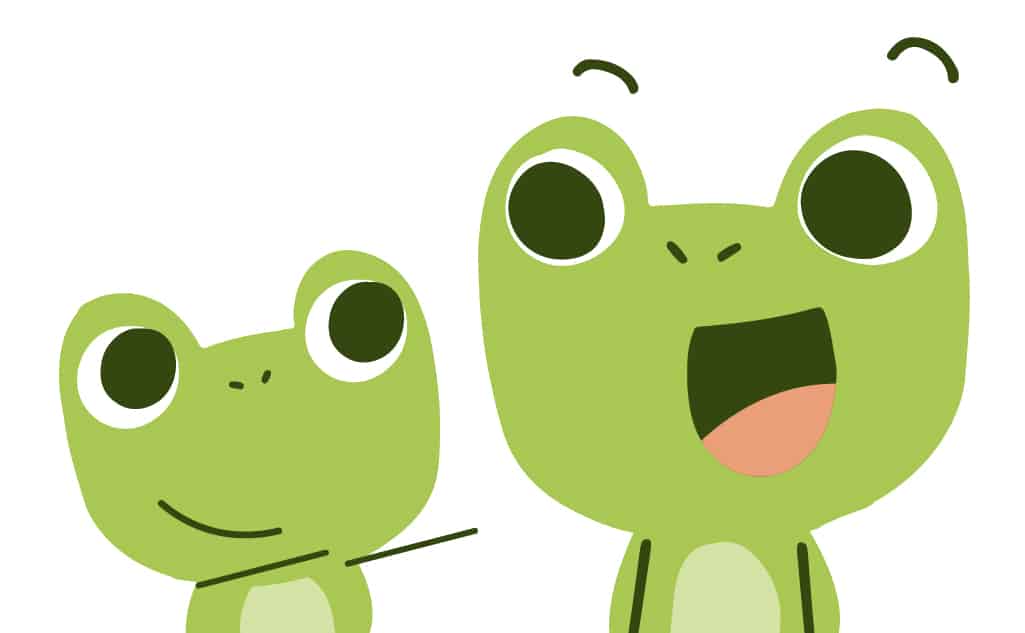
Linking Verb Example Sentences:
I am shorter than my brother.
We became best friends ten years ago.
This sweater feels itchy.
All the kittens were playful.
Helping Verbs
Helping verbs, also known as auxiliary verbs, do not show action either. They help the main verb describe an action.
A helping verb comes before the main verb and assists that verb to show the action.
There are twenty-three verbs in the English language that can be used as helping verbs. Some of the most common include: “is, are, am, was, were, should, must, need”.
Helping Verb Example Sentences:
The squirrels have eaten all the nuts.
We must finish the project today.
They are jogging around the block.
He can speak four languages.
Learn more about verbs with this video!
You’ll want to watch this video and share it with your elementary students to expand their learning.
Compound Verbs
Compound verbs combine two words to create a new verb.
This is the same idea as compound nouns but with actions this time!
Whether they are one or two words long or hyphenated, it’s important to recognize this variation of the verb. They can include a verb and a preposition, two verbs, a verb and a noun, or even an adjective and a verb.
Compound Verb Example Sentences:
Try to get along with your brother.
The teacher proofreads each essay.
I colour-coded my bookshelf.
The airline overbooked the flight.
Verbs give a sentence momentum, that’s for sure, but when an adverb is added it just takes that sentence up a notch.
Adverbs
Adverbs are words that give more detail about the verb.
But that’s not all!
Adverbs can also be used to describe adjectives, other adverbs, clauses, prepositions, and even entire sentences.
An adverb answers the question of how often, when, where, or how an action occurs. Let’s take a look at five common adverbs.
Adverbs of Manner
Adverbs of manner describe the way in which something is done.
Adverbs of Manner Example Sentences:
The teacher spoke clearly.
He dances beautifully.
The students answered all of the questions correctly.
She swam well in the lake.
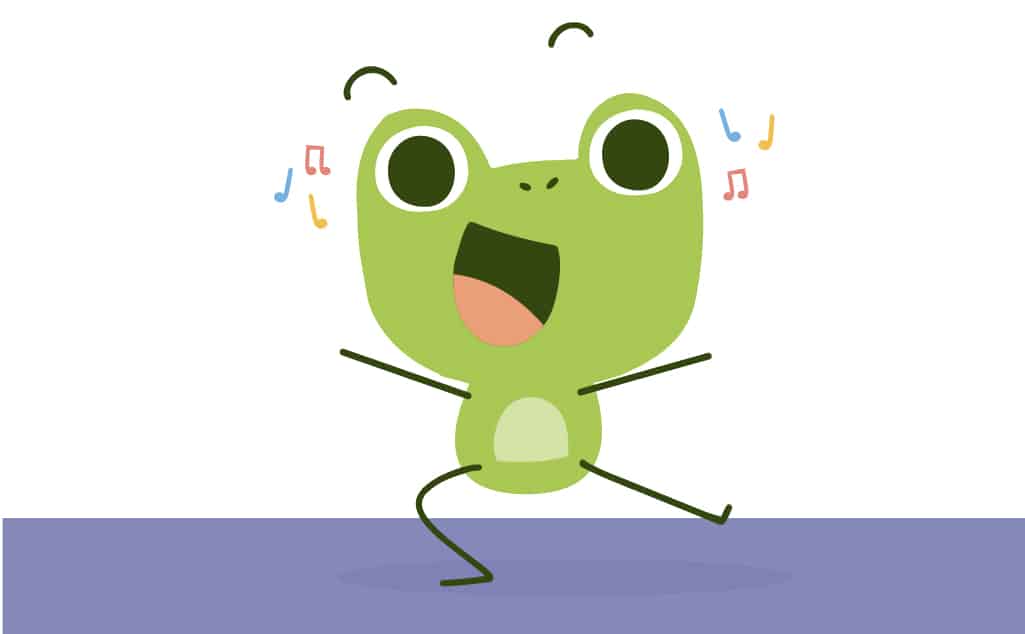
Adverbs of Time
This one is pretty straightforward. Adverbs of time tell when something is happening.
Adverbs of Time Example Sentences:
Never postpone what you can do today until tomorrow.
We will eat dinner later.
They went to the lake last week.
I like to go to bed early.
Adverbs of Frequency
Adverbs of frequency outline how often something is done.
Ranging from always to never with words such as often, sometimes, and rarely in between, adverbs of frequency give good information!
Adverbs of Frequency Example Sentences:
He is vegan and never eats meat.
The Montessori teacher rarely assigns homework.
We seldom eat fast food.
My dad always drinks coffee with breakfast.
Adverbs of Place
Adverbs of place do exactly as their name states – they describe where something happens or where it is.
Adverbs of Place Example Sentences:
We walked around the park.
There are bugs living underneath that rock.
My grandparent’s house is nearby.
I looked everywhere for my pencil.
Adverbs of Degree
Adverbs of degree tell us the intensity of something.
Adverbs of Degree Example Sentences:
The cake was insanely good.
I just finished reading that book.
My cat is uncommonly large.
Some fungi are extremely toxic.
My upper elementary students love this adverb song!
Who doesn’t love a little School House Rock parts of speech song to get a concept across to students?
Adverbs help bring a sentence to life, but what about the preposition? It’s an important part of speech for kids to practice, that’s for sure. Let’s find out more!
Prepositions
Prepositions provide extra information about the relationship between a noun or pronoun and another part of the sentence. Simply put, they tell you where something is in relation to something else in the sentence.
You might have already guessed it, but there are different types of prepositions, each relating to particular types of information.
Just note that some prepositional words make an appearance in several different categories of prepositions. It’s all good!
Prepositions of Time
Prepositions of time indicate when something happens.
Prepositions of Time Example Sentences:
He was born on the first day of January.
I can meet you in an hour.
My dad is always up before dawn.
I’ll see you at lunch.
Prepositions of Place
Prepositions of place indicate the location of someone or something. The three prepositions of place are: “at, in, on”.
Note that some of these prepositions double as prepositions of time. In order to fully understand how words are used in a sentence, kids need to study the parts of speech!
Prepositions of Place Example Sentences:
My dog likes sleeping on the bed.
There are tomatoes growing in the garden.
She forgot her lunchbox at school.
Your painting is hanging on the wall.
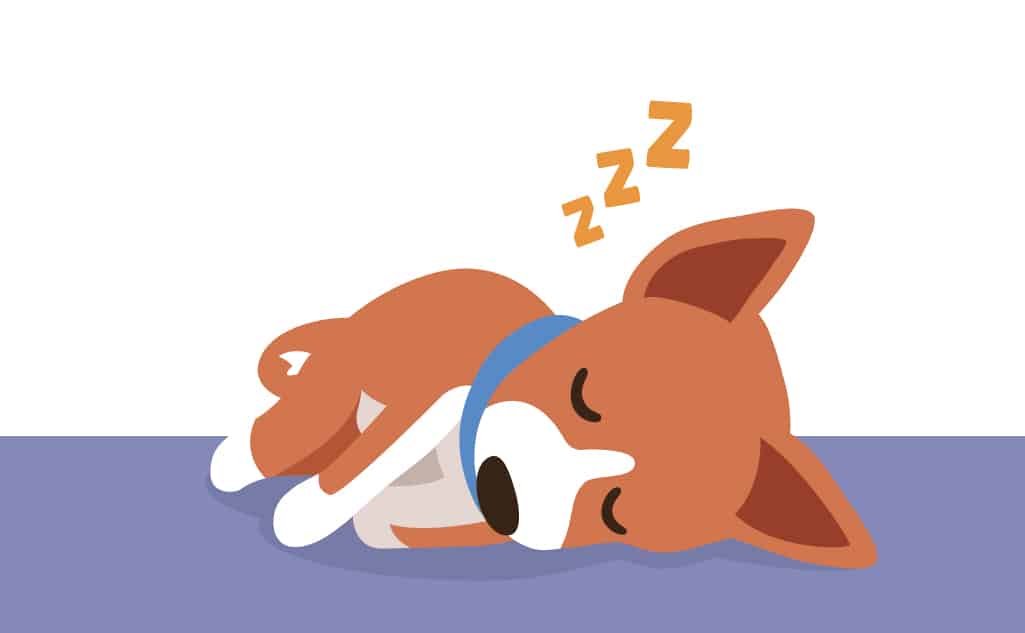
Prepositions of Movement
Prepositions of movement are typically paired with action verbs and indicate movement from one place to another. Think of it as a destination or location
The most commonly used preposition of movement is ‘to’, but there are many other words frequently used as prepositions of movement.
Prepositions of Movement Example Sentences:
She ran to the park.
The train went through the tunnel.
We drove under the bridge.
They rode bikes down the mountain.
Prepositions of Manner
Prepositions of manner show how something is done or how it happened.
Some examples of prepositions of manner are: “in, like, by, with”.
Prepositions of Manner Example Sentences:
The children go to school by bus.
My family went to the train station in a taxi.
She runs like a cheetah.
The teacher greeted his students with a smile.
Prepositions of Measure, Standard, Rate, and Value
Prepositions of measure, standard, rate, and value – also knowns as prepositions of quantity – are used to indicate the amount of something.
Some examples of prepositions of measure are: “by, of, to, than, from”.
Prepositions of Measure, Standard, Rate, and Value Example Sentences:
The candy store sells candy by the pound.
Your shoe size is larger than mine.
He lives two miles away from me.
I bought a pound of chocolate.
Preposition of Agency
Prepositions of agency show a casual relations ship between a noun or pronouns and other parts of a sentence.
‘By’ and ‘with’ are the most commonly used prepositions of agency, but they are not the only ones. ‘Without’, ‘with the help of’, and ‘with the assistance of’ are other ones.
Prepositions of Agency Example Sentences:
They are going to travel with their dog.
These slippers were made by my grandmother.
It’s hard to play basketball without a ball.
We could climb the mountain with the help of a rope.

Preposition of Possession
Prepositions of possession express who or what someone or something belongs to.
Prepositions of Possession Example Sentences:
This book once belonged to my grandfather.
She is a friend of mine.
The cat with the short tail is adorable.
Ottawa is the capital of Canada.
Preposition of Source
Prepositions of source indicate the origins, or roots, of something.
Prepositions of Source Example Sentences:
I picked the apples from our orchard.
The dog was warmed by the heat of the fireplace.
It’s always nice to be hugged by a friend.
I’ll see you by lunch.
Phrasal Prepositions
Phrasal prepositions, also known as compound prepositions, are a group of two or more words that act the same as prepositions.
Phrasal Preposition Example Sentences:
There is a lake in front of my apartment.
At the moment we are studying.
My dog is by far the cutest.
On average, I drink four glasses of water every day.
Conjunctions
Conjunctions connect words, phrases, and clauses in a sentence. This part of speech can be categorized in three ways.
Coordinating Conjunctions
Coordinating conjunctions bring together words, phrases, and clauses that have equal importance. The acronym FANBOYS is often used to remember the seven coordinating conjunctions, which are: for, and, nor, but, or, yet, so.

Coordinating Conjunctions Example Sentences:
The horse eats apples and carrots.
Their van was dirty, so they washed it.
The children wanted to order pizza, but no one had any money.
We can go to the park, or we can go to the movies.
Subordinating Conjunctions
A subordinating conjunction connects an independent clause to a dependent clause in a sentence.
Subordinating Conjunctions Example Sentences:
Soon after arriving at the new school, the child made new friends.
I can’t go to the party because I’m going away that weekend.
Although she likes animals, she will not get a pet.
We don’t need to go to school tomorrow since it’s a holiday.
🤔 FYI: An independent clause features a subject, a verb, and a complete thought. A dependent clause also contains a subject and a verb, but it does not express a complete thought.
🧐 REMEMBER: Dependent clauses cannot stand on their own. They do not make sense without an independent clause.
Correlative Conjunctions
Correlative conjunctions are unique because they come in pairs.
Two words work together to make sentences make sense.
Here are just a few correlative conjunction couples: “both/and,
either/or, neither/nor, not/but, not only/but also, as/as”.
Correlative Conjunctions Example Sentences:
Neither he nor his friends signed up for karate.
I visit my grandmother as often as I can.
He is not only an athlete but also a musician.
I will eat either carrot cake or chocolate cake for dessert.
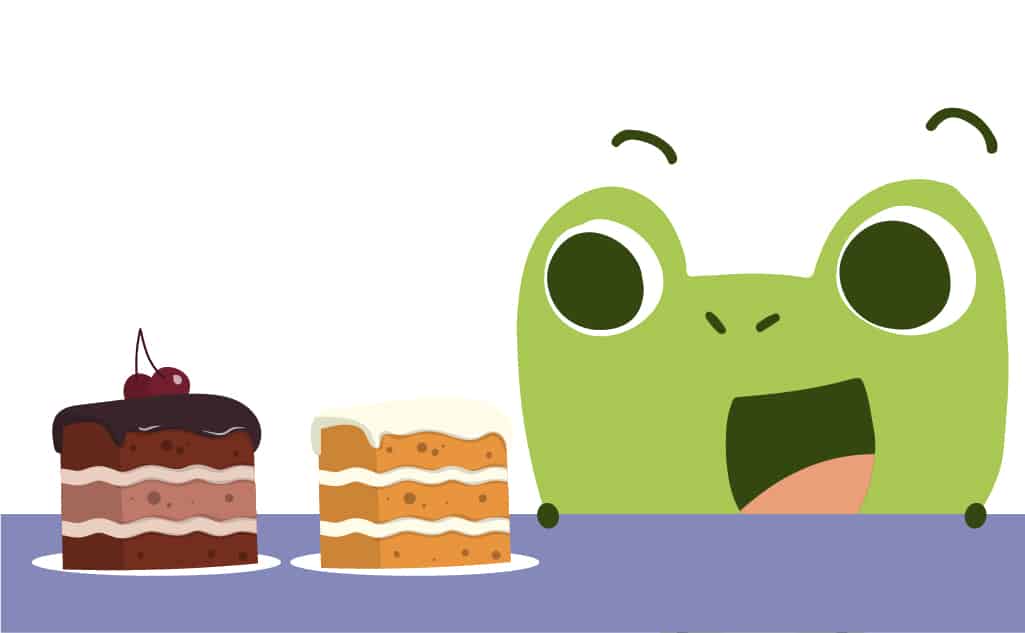
While the conjunction functions to connect words in a sentence, the part of speech for kids to really get excited about is the interjection!
Interjections
Interjections convey thoughts and feelings.
While these small words have no grammatical connection to the sentence, they are however injecting emotion into the words around them.
For the most part, interjections are followed by an exclamation mark. Often seen in comics and even in art, interjections really bring a sentence to life.

Interjection Example Sentences:
Shh! The movie is about to start.
Yummy! The cake was delicious.
Bravo! What a great performance.
It’s time for me to go. Cherrio!
One more song!
Did you think we would leave you without an emotion-filled parts of speech song specifically about the interjection to share with your students?
Never! You have to check this one out.
So there you have it, a comprehensive guide to the eight parts of speech for kids.
💡 Teacher Tip: Have fun with the parts of speech!
Check out our Parts of Speech Scavenger Hunt printable. It’s the perfect follow-up activity for working with nouns, proper nouns, adjectives, verbs, and even prepositions.
You might also like our Vocabulary Graphic Organizer Template for learning new words.
Three cheers for using games in the classroom and making language learning so fun!
Warning! Some Words Serve Many Parts of Speech
So, there are eight parts of speech for kids to learn. And as we’ve discussed, all words fit into at least one of the eight categories.
Sounds straightforward and easy to grasp, doesn’t it?
Well, then this would be a great time to let you know that an individual word can function as more than one part of speech.
Wait! What?
The same word can be a noun in one sentence and a verb or adjective in the next depending on the context and the role the word is playing.
Let’s look at an example with the word ‘book’ used in two different ways.
The teacher read the class a book about submarines.
The teacher wants to book tickets for the class to go to the museum.
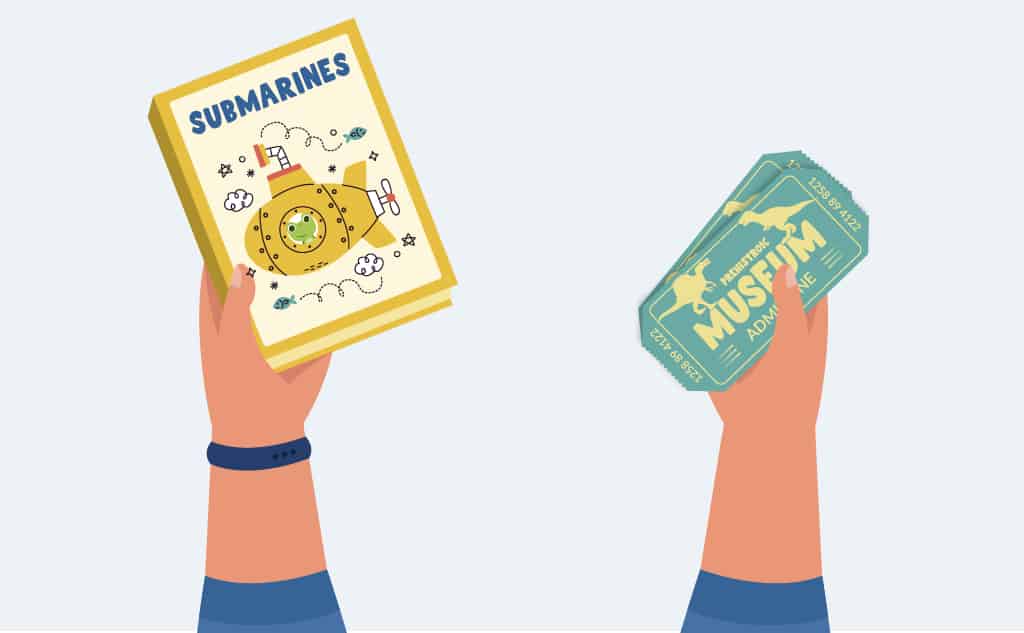
The word ‘book’ functions as a noun (thing) in the first sentence and a verb (action) in the second sentence.
Isn’t that confusing?!?
This is why understanding parts of speech is helpful for determining the correct definition of a word and understanding the context of sentences.
The Montessori Parts of Speech Grammar Symbols
A big difference between Montessori vs traditional schools is the use of specialized materials to teach abstract concepts. Across all subject areas, Montessori students actually get their hands on their learning.
The Montessori materials are really something special. Crafted with precision by Dr. Maria Montessori, each Montessori material holds a distinct purpose.
Sure they look beautiful, but it’s their ability to make sense of abstract concepts that amazes me.
While the spotlight often shines on Montessori math materials like racks and tubes for division or the checkerboard for multiplication, it’s the Montessori language materials that I truly appreciate.
That’s right! Amidst the many materials to marvel at, it’s the unassuming grammar symbols’ simplicity that sparks my enthusiasm for elementary language lessons.
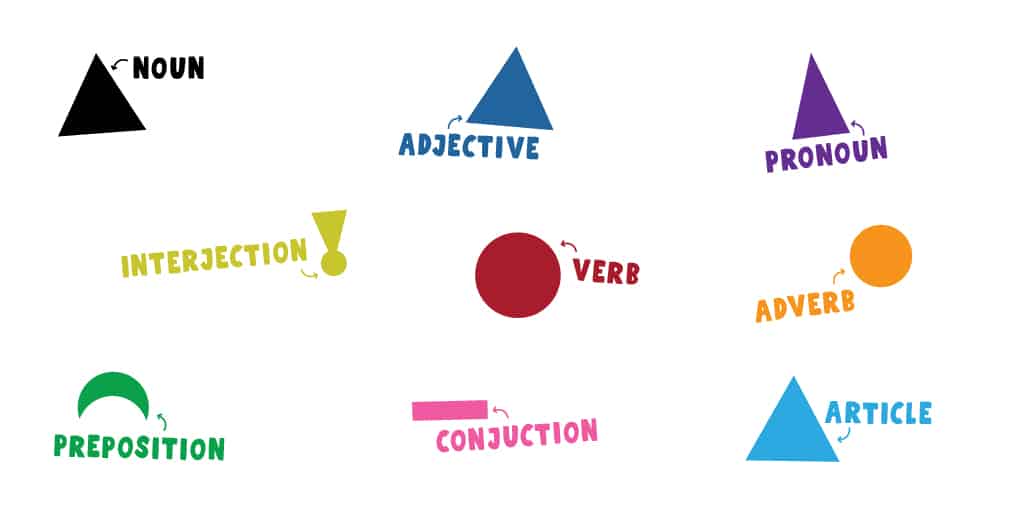
Knowing that children are attracted to colours and shapes, Montessori created a system of coloured symbols to represent the different parts of speech as well as the article. Each shape and colour has a specific job in a sentence or phrase.
The Montessori grammar symbols are important and useful material at the elementary level. They lead to students having a firmer grasp of how words function in English.
The Shapes and Colours of the Montessori Grammar Symbols
The grammar symbols are great because they provide a sensorial reinforcement to learning the parts of speech. They each have a specific shape and colour that students become familiar with.
On top of that, these symbols help improve hand-eye coordination as well as patterning skills.
The noun is represented by a black triangle. The triangle stands for the pyramid, one of the first human structures – and a strong, stable, and solid one at that.

There are other members of the noun family and they are the adjective, the article, and the pronoun. To keep it consistent, the triangular shape is used for all members of this family, but you’ll notice that each triangle is differentiated by size and colour.
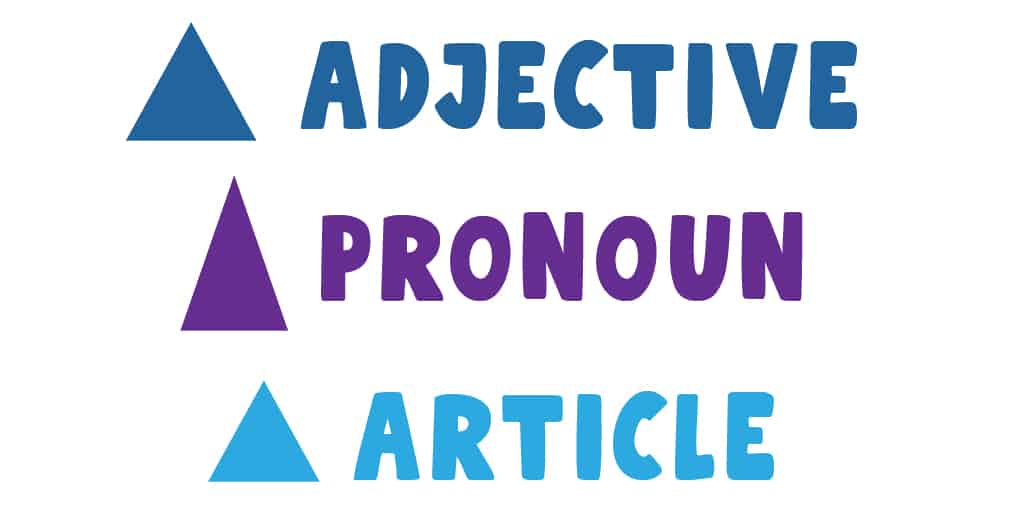
The verb is symbolized by a red circle. The circular shape demonstrates its ability to move. The colour represents the sun which is vital for life. So we can say that the verb gives movement and life to a sentence.

The adverb is identified by a smaller orange circle and its existence in a sentence depends on the verb.

The conjunction is a small pink rectangle, sort of like a bar, which represents how a link in a chain connects parts together.

The preposition is a green crescent which symbolizes a bridge.

The interjection is a gold triangle with a circle on top. Interestingly, it combines the symbols of the noun and the verb together. The shape resembles a keyhole giving the reader a glimpse into the emotion of a sentence.

While the Montessori grammar symbols consist of the 9 basic coloured shapes outlined above, there are an additional 10 advanced symbols that Montessori students can learn when they are ready. Enough to keep the learning going throughout the years!
With the guidance of the grammar symbol materials, the child quickly learns the parts of speech and how they function within a sentence.
After reaching a solid understanding of the parts of speech, students can progress on to learning the parts of a sentence and how they function.
Free Parts of Speech Chart for Kids
The 8 parts of speech are easier for kids to digest when they are organized neatly in a chart. That’s why we created this Montessori-aligned parts of speech chart for your classroom.
Sign up for our monthly newsletter to get a printable version of this parts of speech study guide.
Hang it on the wall in your classroom or at home, or put it in a safe place and use it as a handout or resource for students.
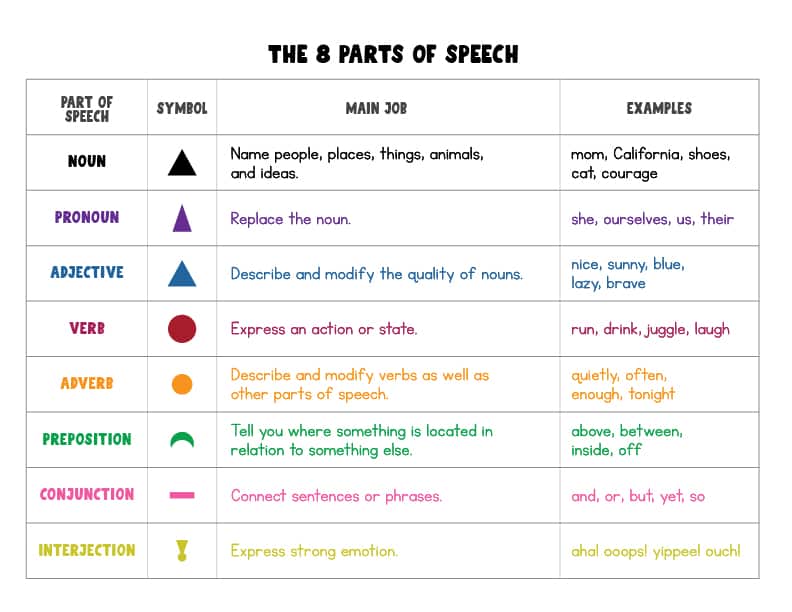
Learning the Parts of Speech is Important for Kids
For the most part, children need to learn to crawl before they learn to walk. Steps need to be taken (pun intended!) when learning any new skill, including how to use the parts of speech in English for kids.
As a Montessori upper elementary teacher, I have had to justify to students and their parents why it’s important for kids to know the function of the conjunction or the difference between auxiliary verbs and linking verbs.
If you want – or expect – children to speak proficiently, then lessons teaching the eight parts of speech for kids should be taught early on.
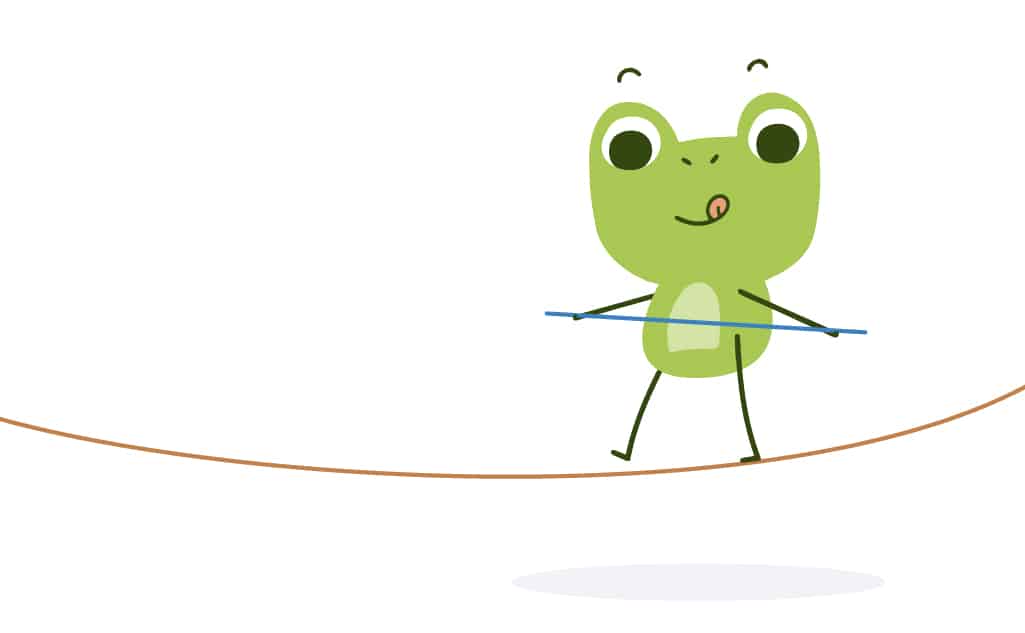
To empower elementary kids in writing compelling sentences, it’s essential to lay the groundwork with fundamental grammar concepts. I firmly believe that understanding the parts of speech is the cornerstone of effective language skills for elementary students.
Studies show – and I’ve observed it firsthand in the classroom – that when lessons covering the parts of speech for kids are introduced early on, it leads to improved reading and writing skills.
💡 Engage your students in hands-on learning of the parts of speech using our Roll a Story dice game for kids!
Check out our blog, where we explore 11 exciting and educational ways to maximize the potential of the Roll a Story printable dice in elementary classrooms.
This creative game is featured as one of the Epic Montessori-Aligned Spring Break Activities for Your Kids.
When to Teach the Parts of Speech to Kids
Ok great, the parts of speech are important for kids to learn and lead to improved reading and writing skills. But you might be wondering, when exactly these grammar lessons should be introduced.
I recommend introducing and practicing common parts of speech like nouns, verbs, adjectives, and pronouns to first and second graders. Then, continue expanding this study throughout their elementary years.
With the presentation of the fourth Montessori great lesson, grade 1 students are introduced to the history of words. From here they are open vessels for learning an endless amount about how words work and what they mean.
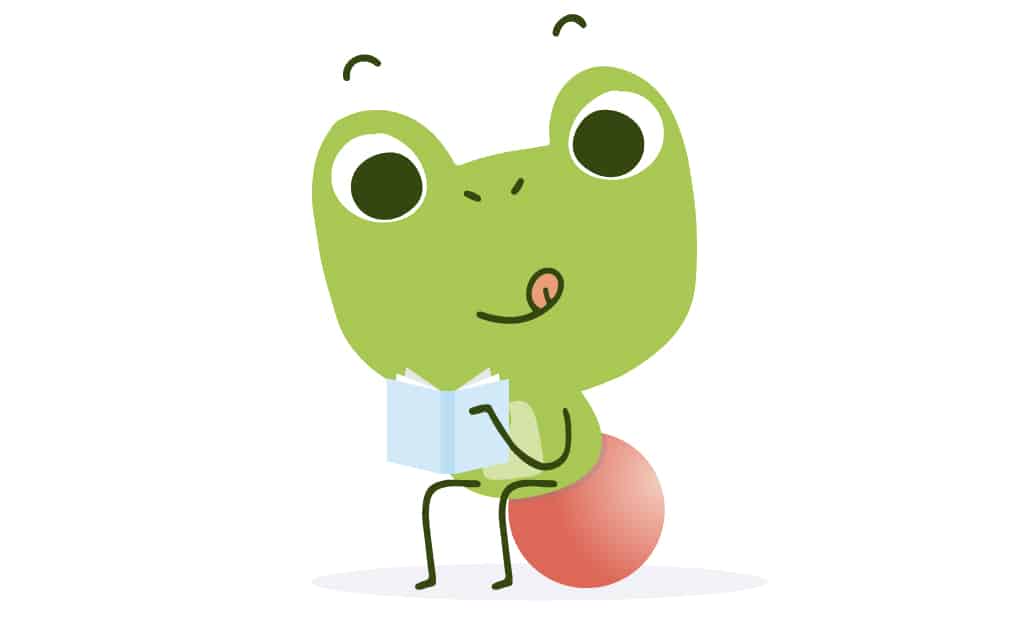
Take your time with the study of parts of speech for kids. Allow students to fully grasp how words function and their roles in sentences.
Provide them with the knowledge and they will start to create complex sentence structures. Or at least that’s what we hope for.
Parts of Speech Posters for Kids
We have created some really fun parts of speech posters for kids to enjoy and learn from. Our eye-catching and engaging dog-themed printable parts of speech posters are perfect for any 6-12 learning environment.
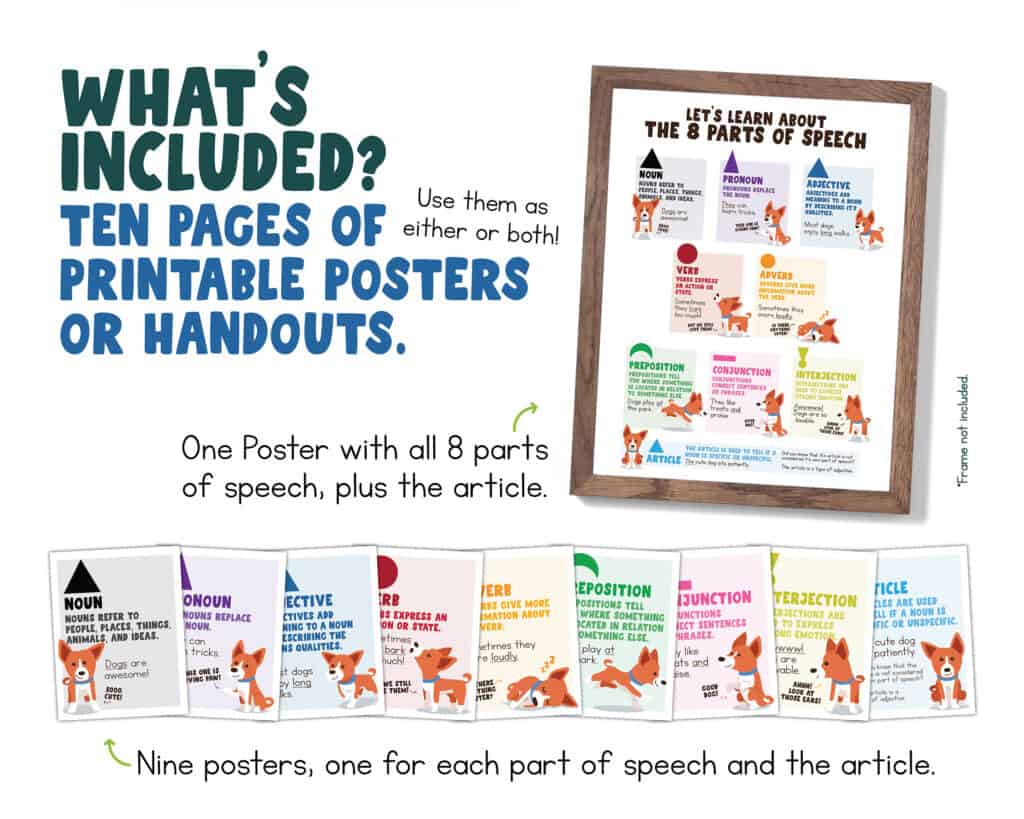
Beneficial for visual learners and animal lovers, these Montessori-aligned posters include the colour-coded grammar symbols. They also include explanations and example sentences for each part of speech.
Great for hanging in your language area as a reminder or guide for students to check in with. They can also be stored away in folders ready for a lesson or reference.
This is one versatile and aesthetically pleasing language material.
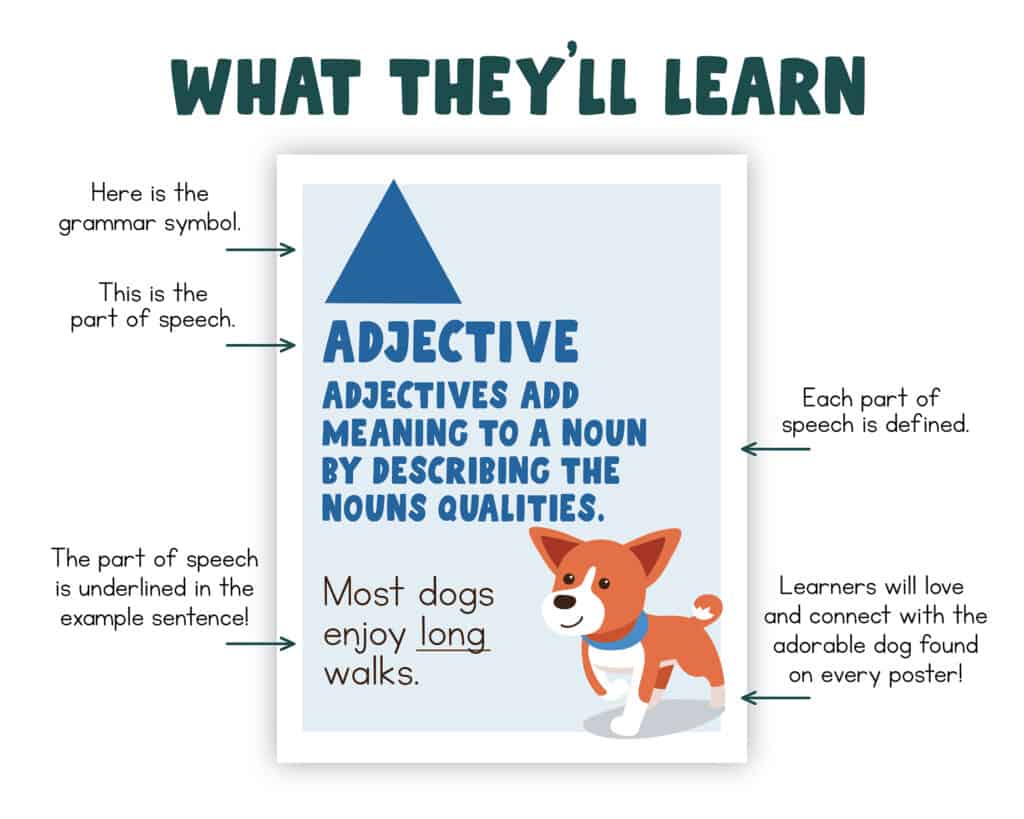
Not teaching parts of speech in a Montessori classroom? No problem!
We also offer a set of frog-themed printable parts of speech posters that are colour-coded to the Montessori grammar symbol colours but do not include the Montessori grammar symbols.
This poster is the perfect way to add a little Montessori magic to any learning space!
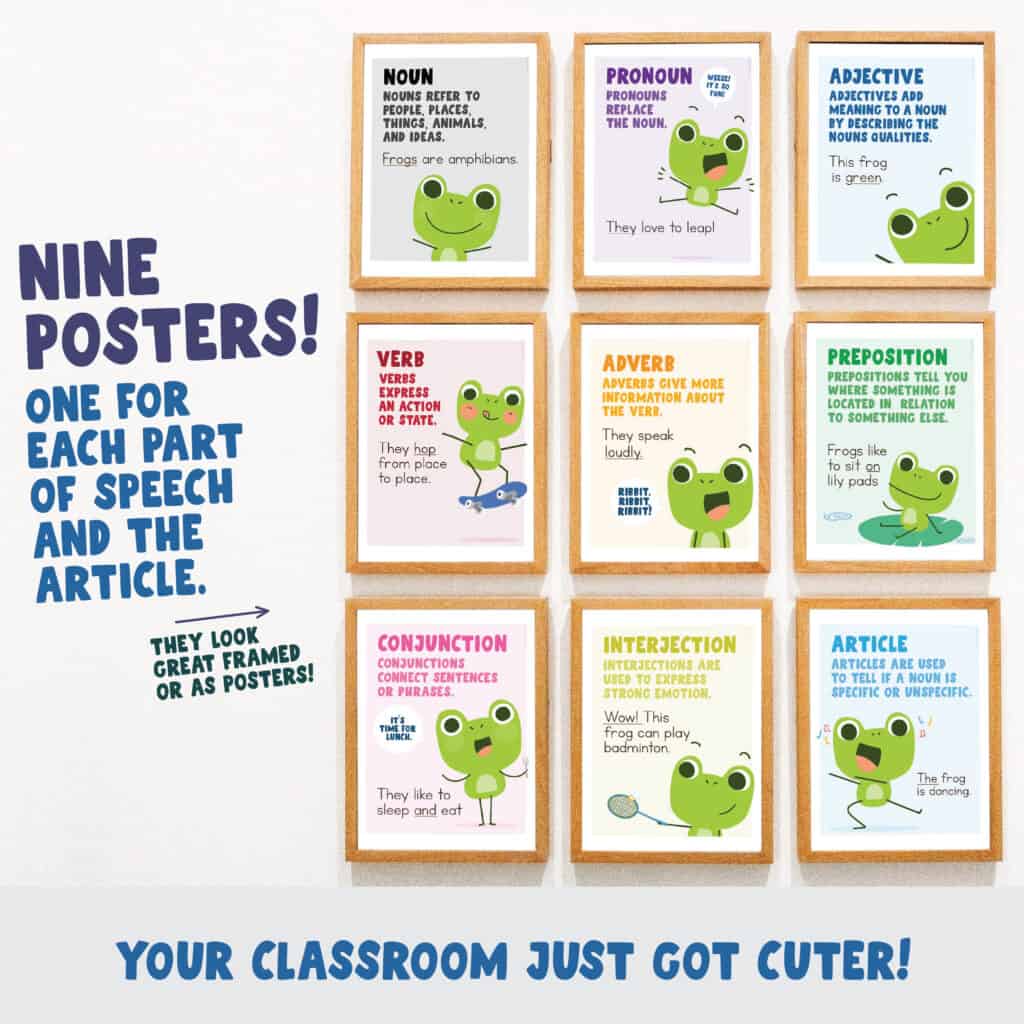
🚀 Boost Your Child’s Vocabulary with the Fun Activities in These Blogs
Book Report Ideas for 5th Grade that Spark Imagination
Your Guide to Starting a Family Book Club Now
Rebus Puzzles for Kids: A Comprehensive Riddle-Solving Guide
Classroom Vocabulary Activities: 11 Post-Picture Book Reading Ideas
The Wrap-Up: The Parts of Speech for Kids
As we finish up this deep dive into the eight parts of speech for elementary students, it’s clear that their significance goes far beyond writing enhancement. The parts of speech are in fact the building blocks of effective communication and language mastery.
Nurturing a solid understanding of the 8 parts of speech during the elementary years is key. This comprehensive guide equips you with the tools to pave the way for your students’ linguistic development.
Happy teaching!
💡 Supplement your parts of speech lessons with these products:
Animal Matching and Memory Game
Parts of Speech Scavenger Hunt Game
Word of the Week
Vocabulary Graphic Organizer
💡 Encourage literacy with these fun activities:
A to Z Scavenger Hunt Template
Reading Challenge: 100 Places to Read Checklist
Printable Rebus Puzzle Guide & Cards
Reading BINGO Cards
Roll a Story Dice Game
Carl the Cantankerous Cat Digital Picture Book + Printable Activity Pack
Periodic Table of Elements Digital Lessons
Alphabet Scavenger Hunt Printable
Math Jokes for Kids and Teachers
📌 Pin this so you can find it later!
